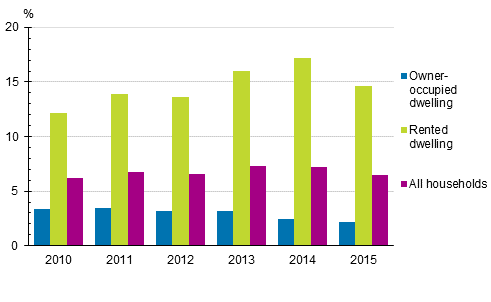Published: 31 March 2017
Slightly fewer have high housing costs
In 2015, a total of 14.6 per cent of households living in rented dwellings were burdened by high housing costs. The share was 2.6 percentage points lower than in the previous year. Among households living in owner-occupied dwellings, the share of households burdened by housing costs has remained nearly the same, at around two per cent. These data derive from Statistics Finland’s income distribution statistics .
Households burdened by housing costs by form of tenure of the dwelling in 2010 to 2015, %

Households burdened by housing costs = the share of the household’s housing costs of the disposable monetary income, excluding housing benefits, is over 40 per cent.
The growth in the number of households burdened by housing costs made a downturn. In 2015, there were 171,400 such households, which is 6.5 per cent of all households. The share was 0.7 percentage points lower than in the year before, and only a little higher (0.3 percentage points) than in 2010, after which the number of households burdened by housing costs started to grow.
The share of households living in rented dwellings that are burdened by housing costs was in 2015 around 14.6 per cent, which was still 2.2 percentage points higher than in 2010 and around 1.0 percentage points higher than in 2012.
Housing costs most commonly burdened were households at-risk-of-poverty 1) and those living in rented dwellings. Housing costs were high for 22.3 per cent of households at-risk-of-poverty and for 3.4 per cent of other households. Their share of disposable monetary income excluding housing benefits was over 40 per cent. Most of households at-risk-of-poverty and households belonging to the two lowest income deciles had a rented dwelling as the form of tenure of their dwelling. Altogether 29.6 per cent of households at-risk-of-poverty living in rented dwellings and 9.5 per cent of households living in owner-occupied dwellings were burdened by housing costs in 2015.
The development was similar based on households’ average income shares of housing costs (median figure). The share of housing costs for households living in rented dwellings in disposable monetary income excluding housing benefits grew from around 24 per cent in 2006 to nearly 27 per cent in 2014. The median for the income share of housing costs for households living in rented dwellings was lower in 2015, 26.2 per cent. The income share of housing costs for households living in owner-occupied dwellings has remained almost unchanged. It has been around 11 per cent since 2013. The median for the income share of housing costs for households at-risk-of-poverty living in rented dwellings was 29.1 per cent and that of those living in owner-occupied dwellings 18.9 per cent in 2015. They were around one percentage point lower than in the precious year.
The difference between households living in owner-occupied dwellings and rented dwellings in income after paying housing costs decreased slightly compared with the preceding year. The median for households’ equivalent disposable monetary income 2) grew in real terms by around 1.1 per cent in owner-occupied dwellings and by 2.1 per cent in rented dwellings. The income levels prior to paying housing costs improved equally somewhat (0.7%) for both groups.
In the first half of the decade, income development has in general been weak. In 2011 to 2015, the real income level of households living in rented dwellings fell (-4.3%), while for households living in owner-occupied dwellings it rose slightly (1.3%) after paying housing costs. Households living in rented dwellings were more often economically inactive than those living in owner-occupied dwellings. The income level after housing costs rose for both economically active households living in owner-occupied dwellings (1.2%) and households living in rented dwellings (1.6%) from 2011 to 2015.
The median for households’ equivalent disposable monetary income after housing costs was EUR 18,400 in 2015. The equivalent median income of households living in owner-occupied dwellings was EUR 22,100 and that of households living in rented dwellings EUR 11,100. Among economically active households, the equivalent median income after housing costs for households living in owner-occupied dwellings was EUR 26,100 and for household living in rented dwellings EUR 17,000 in 2015.
1) Persons are classified as being at-risk-of-poverty when the households’ disposable monetary income per consumption unit is below 60 per cent of the median income.
2) Equivalent income is the household’s disposable income divided by the number of consumption units in the household. The consumption units are based on the OECD’s modified scale. One adult in the household is one consumption unit. Other persons in the household aged at least 14 are 0.5 consumption units each and children aged 0 to 13 are 0.3 consumption units each.
Source: Income distribution statistics 2015, Statistics Finland
Inquiries: Marie Reijo 029 551 2547
Director in charge: Jari Tarkoma
Publication in pdf-format (190.9 kB)
- Tables
-
Tables in databases
Pick the data you need into tables, view the data as graphs, or download the data for your use.
Updated 31.03.2017
Official Statistics of Finland (OSF):
Income distribution statistics [e-publication].
ISSN=1799-1331. Income, housing and housing expenditure 2015. Helsinki: Statistics Finland [referred: 19.4.2025].
Access method: http://stat.fi/til/tjt/2015/03/tjt_2015_03_2017-03-31_tie_001_en.html

